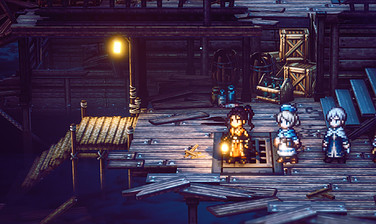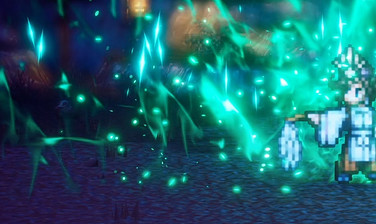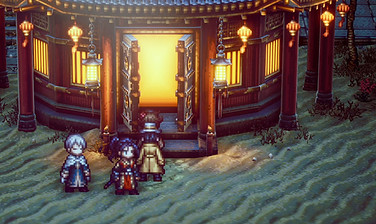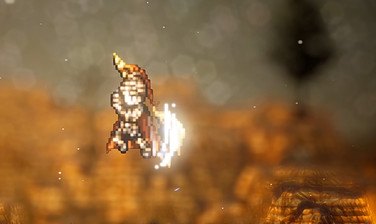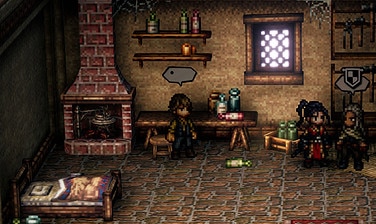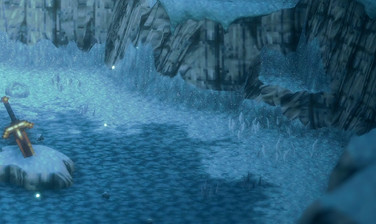New to the Octopath Traveler series or JRPGs in general? This guide will help you learn how combat works in Octopath Traveler II and what each element of the UI means during fights in Octopath Traveler 2!
Combat Interface Overview
Octopath Traveler 2 uses more of a traditional, or classic JRPG combat interface. Below is a look at that interface and how each part of it works, so you know how best to use it.

As marked in the above image, the parts of the UI are as follows:
- Current Turn Order
- Upcoming Turn Order
- Character Status
- Boost Indicator
- Command List
- Foe Shield Points and Weaknesses
- Game Speed Setting
With each part defined, let’s talk about each element respectively.
Current Turn Order
As the name indicates, the Current Turn Order shows the Action Order of each ally and foe in combat.
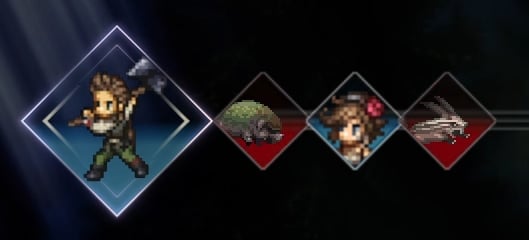
This can be used to figure out when your character get to move. You can also use it as an indicator of when to expect to take damage.
As you highlight enemies they’ll also be highlighted here, making it easier to tell which foe is attacking in which order. This can help you adjust in combat and break foes that have turns between your current character and your next acting character. This can prevent you from taking extra damage when used well.
Upcoming Turn Order
Upcoming Turn Order works the same as the Current Turn Order, just showing the next turn, rather than the current one.
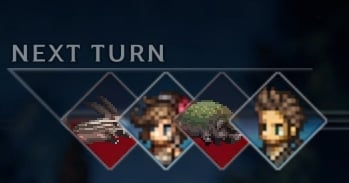
It’s important to pay attention to this, because as you take certain actions, like Defend for example, it can alter the turn order next turn. This will be affected by Buffs, Debuffs, and other similar effects as well.
It’s a great way to figure out possible situational differences like “I need to heal this turn” or “I can block and get off a stronger heal next turn with more BP”
Character Status
The Character Status section indicates four valuable pieces of information: Your Health Points (HP), Stamina Points (SP), Boost Points (BP) and your current Status effects. Each Character has their own independent display for this information.
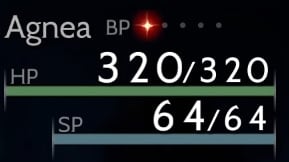
HP is a very commonly used system, across multiple genres of games. If it reaches zero, your character is considered dead and unable to act unless revived.
SP is Octopath Traveler’s version of Mana. This resource is used to cast spells and use abilities. Without it, you’ll be limited to performing an action that does not require it, such as basic attacks, defending, or using an item.
BP is used to empower your attacks and skills. It affects different skills in different ways including additional attacks for some multi-hit attacks, increased damage or healing, increased duration of buffs/debuffs, or increased chances of succeeding with chance-based skills like the Thief’s Steal command.
While not pictured in the example above, the area to the left of the Character Status will also display Status Effects applied to your character and their duration. This will include Positively Increased Attrbutes (Buffs), Negatively Decreased Attributes (Debuffs), and Afflictions (Status Effects that do not apply directly to Attributes)
When multiple effects are applied at once, only 3 will be displayed at a time.
Command List
The Command List the list of Commands you can give to each of your characters in battle.
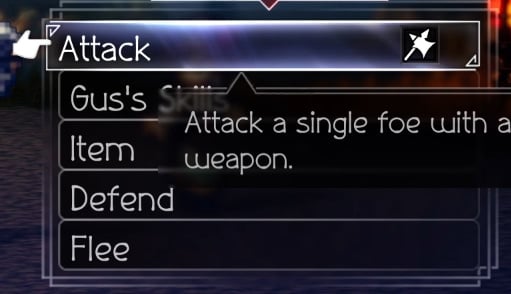
All Characters have 4 shared options: Attack, Item, Defend, and Flee.
Attack performs an attack with the selected weapon. You can change weapon you attack with (if your character can use more than one type) by using left or right on your Left Stick for consoles or A and D on PC.
Item brings up your list of available combat items. You can then select an item to use from the list of items. These can provide recovery effects, apply negative statuses to foes, remove negative status effects from your allies, or deal damage to foes.
Defend makes your character block until their next turn. This reduces incoming damage by a good bit, while also moving up the character’s action to be earlier next turn.
Flee attempts to escape the current encounter. This only work for random encounters and cannot be used in boss encounters. This action also will not always work and is generally determined by the level difference between you and your foe. If the Level difference favors the enemy, it’ll be harder to escape; if it favors you, it’ll be easier.
Each individual character will also have two or more additional options specific to them. In the list above, the Dancer’s story companion Gus has Gus’s Skills. Typically this will consist of the Skill options for their Main Job and Battle Job. Most characters also have a special command related to their base class.
Boost Indicator
The Boost Indicator lets you know if Boosting is available. Once you apply Boost, it also lists the number of boosts added.

In addition to this indicator, the tooltip for the skill or attack will also change to reflect any direct changes to the skill. It’ll note things like extra turns for buffs or debuffs or additional attacks. However, it will not tell you the increase in damage or healing in any way.
Enemy Status
The Enemy Status indicator is much like the one for the Party. The Enemy Status conveys four things that help with combat which consists of: Weaknesses, Shield Points, Status Effects, and Vulnerability.

In Octopath Traveler, each enemy type has its own set of weaknesses. This indicator below the enemy will list all their weaknesses as revealed. Most enemies will not have more than 5 weaknesses. Since the weaknesses are set per enemy type, they remain permanently revealed once they have been revealed.
Weaknesses can be revealed manually by hitting a foe with an unrevealed weakness, or by using the Scholar’s Analyze Skill. The Scholar’s Talent, Study Foe, will also reveal one weakness at the start of each combat.
In Octopath Traveler all foes have Shield Points, displayed as a number over a blue shield. Shield Points indicate how many times they need to be hit with an attack they have a Weakness to in order to cause a Break. While Shielded, enemies will take less damage from all attacks until a Break occurs.
Weaknesses are the damage type(s) that can reduce a Foe’s Shield Points. It’s important to take advantage of these whenever possible as a foe is unable to act for for a short period.
Vulnerability is a bit more niche, as not all foes make use of it. This typically indicates when a foe can be targeted and when they’re immune to damage.
Game Speed Setting
The Game Speed setting will determine how quickly attack skill animations will play. This can be set to Normal Speed, or Double Speed.

Normal Speed is the default game speed and is recommended for most gameplay. Double Speed helps you get through battles faster, which helps if you’re just quickly defeating enemies to gain Experience Points (EXP) or Job Points (JP).
Combat Mechanics explained
With the UI elements covered, we can go into more depth about how they interact and how to make use of them.
Damage Types
A good majority of the Skills and Spells in Octopath Traveler 2 will deal damage. There are the obvious exceptions like those that apply buff, debuffs, or healing; and even then some of those can be made to have a chance to apply damage.
Regardless of the source all damage in Octopath Traveler falls under the Physical or Elemental category. There are 6 Physical Damage Types, and 6 Elemental Damage Types.
Physical Attacks are always performed with the equipped weapon of their respective type. This means their effectiveness is tied directly to the weapons equipped of the appropriate type. The Physical Damage Types are Sword, Polearm, Dagger, Axe, Bow, and Staff.
Elemental Attacks only care about your Elemental Attack stat. Elemental Attacks will always use the weapon that provides the highest Elemental Attack bonus. The Elemental Damage Types are Fire, Ice, Lightning, Wind, Dark, and Light.
It’s important to make note of the specific order of each category of damage types. Weaknesses will always be in the listed orders, with Physical Types listed first. This can help you figure out weaknesses simply based on the weaknesses you have revealed.
Breaking and Boosting
Now, take advantage of that knowledge to Break your enemies!
A Break occurs when an enemy’s Shield Points reach zero. When Broken, an enemy will take extra damage, regardless if they are weak to it or not. You’ll want to save your hardest-hitting attacks and BP for when this occurs for maximum damage.
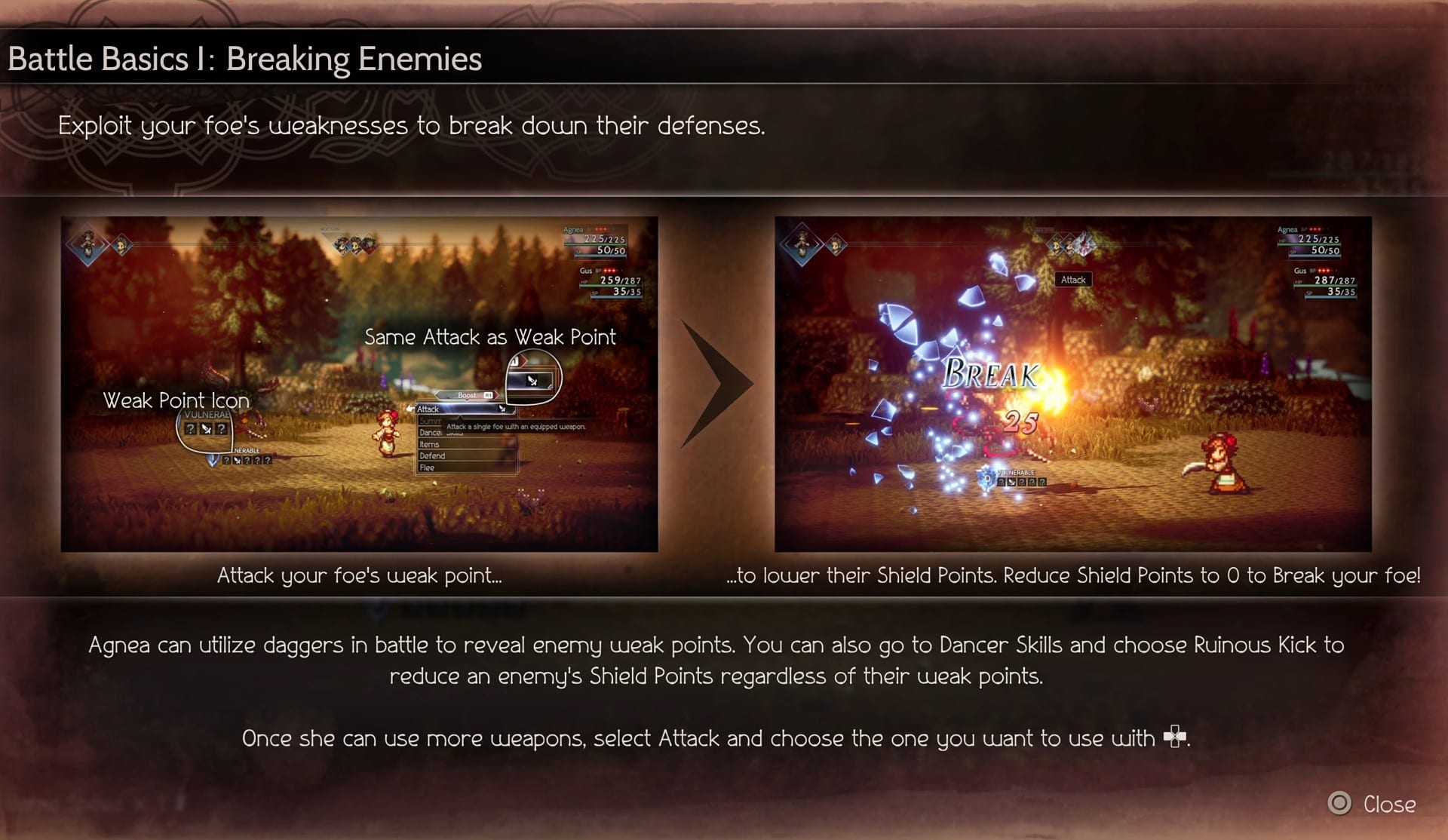
Additionally, they’ll be unable to act in both the current turn and the upcoming turn. This means if you move before an enemy and Break them, you’ll be able to hit them twice before they recover and can attack again.
The Best way to take advantage of a Break is to Boost your attacks. This gets you the maximum damage and most effectiveness out of your BP.

When Boosting, you can use up to three BP on a single attack, Skill, or Spell. Each BP can have a variety of effects, below is a quick list of the most common of them.
- Increased Damage
- Increased Number of Hits
- Extended Duration of Buffs, Debuffs, and Afflictions
- Increased Healing
Most skills that deal a single instance of damage will only increase in damage, while multi-hit attacks will have their attack count increased instead. Buffs and debuffs will gain an extra 2 turns per BP spent on their application. Healing will be increased, which includes the amount of health recovered when using a Spell to Revive an ally.
Latent Powers
Latent Powers are a new feature of Octopath Traveler 2, and give each of the eight travelers a unique skill or effect that only they can use.
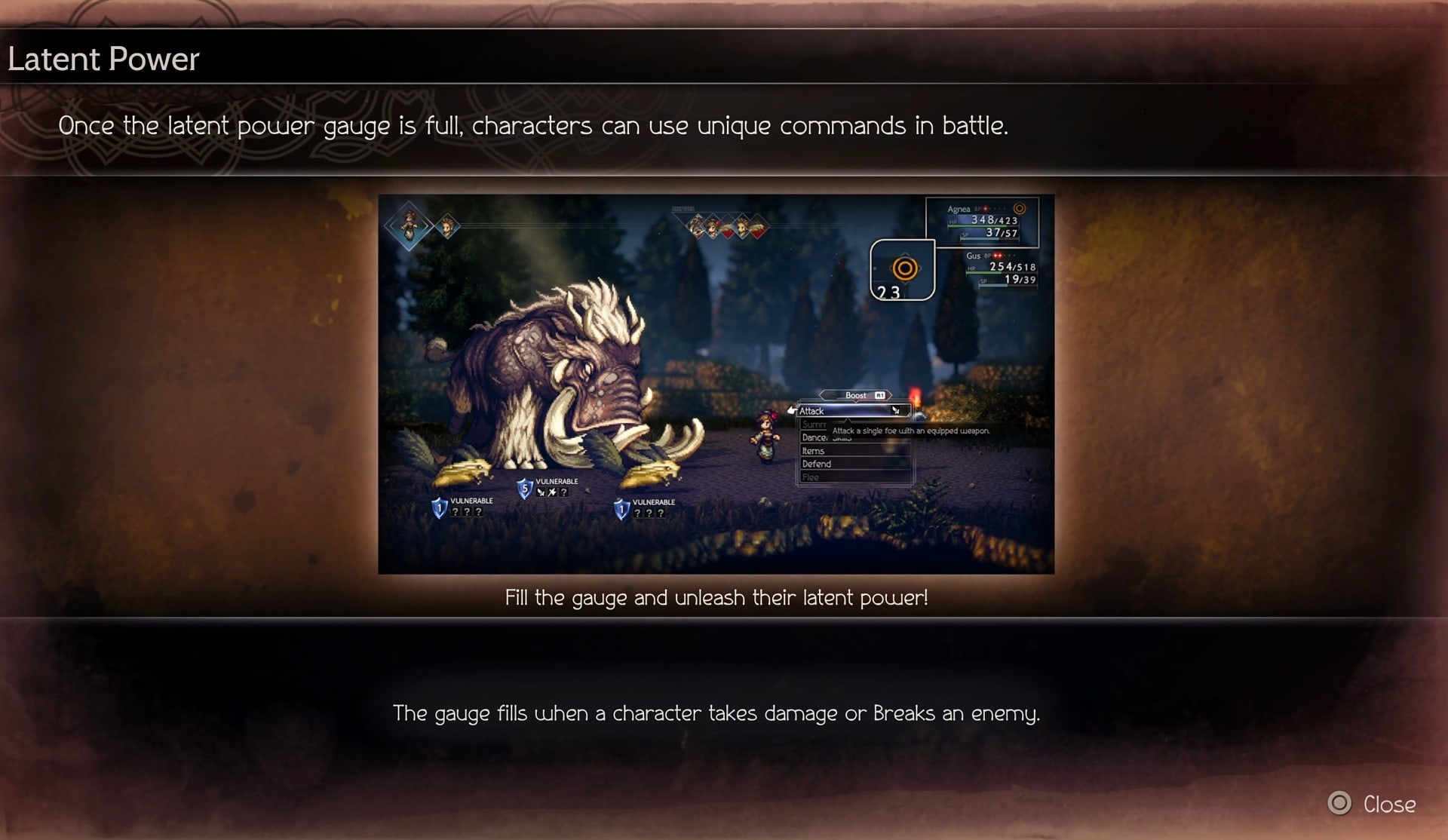
These unique and powerful effects aren’t available until the end of each character’s first chapter of their story or immediately if skipping their initial story for the second character and beyond.
Latent Powers work off of a gauge that fills when taking damage or Breaking foes. In most cases a break will generally fill the meter by 25%, while taking damage will fill it according to the percentage of damage taken.
The Latent Power Gauge must be completely filled to activate the Latent Power. This prevents you from building up multiple uses. However, effects that contribute to breaking can refill the gauge at the same time it is depleted.
Status Effects
There are three categories of Status Effects: Buffs, Debuffs, and Afflictions. While the game doesn’t quite make this distinction outside of a few skills, it helps to keep things more organized for yourself.
Buffs and Debuffs raise or lower the respective Attributes by roughly 50%. These Attributes are Physical Attack, Physical Defense, Elemental Attack, Elemental Defense, Accuracy, Critical, Speed, and Evasion.
















Afflictions are effects that do not affect your Attributes. These consist of the following effects: Poison, Silence, Blindness, Terror, Unconcious, Sleep, and Confusion.

Poison deals damage each time a character acts. Poison will not deal damage if the battle ends from the character’s action. This can be removed with the Herb of Healing item.

Silence prevents you from using any Skills or Spells. This limits you to basic attacks, items, or blocking. This can be removed with the Herb of Clamor item.

Blindness lowers the accuracy of Physical Attacks and Skills. This can be just as punishing to a physical-based damage character as the Accuracy Debuff. This can be removed with the Herb of Light item.

Terror prevents the gain and use of BP. While uncommon, this effect can disrupt a lot of strategies for bosses and tougher enemies. This can be removed by the Herb of Valor item.

Unconscious prevents a character from acting. This means they lose their turn. This can be removed with the Herb of Revival item.

Sleep prevents a character from acting, but is removed upon receiving damage. This is similar to Unconcious, with the distinction that the status is removed when damage is taken. This can be removed by the Herb of Awakening item, or by inflicting damage to the afflicted character.

Confusion makes a character randomly attack. These attacks will always target themselves or allies. This can be removed with the Herb of Clarity item.
Additionally, the Apothecary’s Rehabilitate skill will remove all Afflictions, and prevent them for a number of turns. This can be an easy way to counter enemies that use them frequently.
You can press the dedicated shortcut button to bring up the explanations of the icons during battle at any time.
The number beside the status effect shows the number of turns the effect will last. If it’s preceded by a X symbol, this indicates the number of times the effect will be active.
We have a great collection of Octopath Traveler 2 Job Guides, where you can learn how to play this class, which other job it synergizes with and which skills to learn first.

